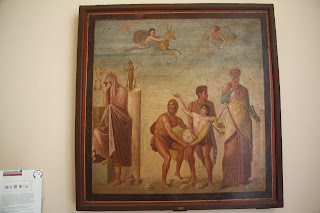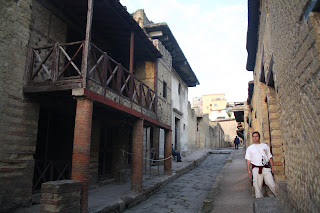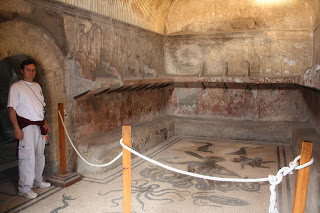Today we were heading back to Naples for a short visit. Seeing as how we'd had so much trouble with the slowness of the Circumvesuviana, and we knew we had to be in Naples bright and early the next day to hop a train to Rome, Handler 2 thought it would be a good idea if we timed how long our trip to Naples would be. It turned out to take just about an hour....which would be cutting it pretty close for the next day. We'd have to leave on the very first train out of Sorrento and hope for no delays in order to be able to make our connections. The Handlers worried, but realaized there was nothing to be done about it just then.
We made our way to the (rather confusing) subway location and picked up a train to the "museum district".
I don't know if you live in a big city, but they're not always the nicest or prettiest of locations. Take Detroit, for instance, where the Handlers work. Large portions of Detroit are not very pretty at all and the Handlers would strongly advise you not to go there. But, in general, cities (even Detroit) try to keep their cultural centers clean and presentable for those tourists that want to visit there.
This is not the way things are done in Naples.
Don't get me wrong, it's not like its a bombed out wasteland or anything. It's just that the Handlers didn't expect the walk from the nearest subway station to one of the most fmaous museums in all of Italy to take them through a very rough seeming park full of sketchy persons and dog doodoo. Lots of dog doodoo. Anywhoo, that's what we call "local color", and it's an important part of travel.
Finally, we arrived at the National Archaeological Museum of Naples. It's got a bunch of big statuary, like this famous representation of the Farnese Bull.

However, the real treasure of this museum is the artwork removed from Pompeii. Apparently, early excavators weren't entirely stupid, because they knew enough to remove some of the best pieces (wall and all) from the city and preserve them indoors. If you're wondering where all the great artistic works of Pompeii are, they're framed in this museum.
 This spectacular mosiac depicting Alexander the Great's victory over Darius was removed from the floor of the House of the Faun that we explored yesterday.
This spectacular mosiac depicting Alexander the Great's victory over Darius was removed from the floor of the House of the Faun that we explored yesterday.
There's also an etire room of erotic art.

Mars cops a feel.
Then it was off to Herculaneum, which, much like Pompeii, was covered and preserved by the Vesuvius explosion of 79 AD. Ancient Herculaneum currently rests directly beneath the modern city of Herculaneum. Here you can see present day apartment blocks resting above the 2000 year old cityscape.

Herculaneum used to be right on the shoreline. These are the shipping docks where citizens gathered hoping for an escape by sea (notice the cliff on the right which indicates current ground level).

Herculaneum was closer to Vesuvius than Pompeii. Although you would think this would make it more subject to wholesale destruction, it ultimatelty resulted in the overall preservation of the city. Since Pompeii was farther from the volcano, it experienced less pyroclastic flow (Google it, it's nasty stuff). The result of this was that Pompeii was buried in a lot less dense material. This means that it was easier to dig out, which ultimately contributed to its excavation (read: looting) as early as the 18th centruty. Herculaneum didn't come to light until much more recently, after the advent of modern archaeological techniques.
Additionally, because of the rapidity with which Herculaneum was buried by incredibly hot material, more "organic" materials such as wood and rope managed to survive. In other words, despite being closer to the killing epicenter, Herculaneum is more intact than its better known sister city. That means you get the remains of people's personal effects, like this original sliding door/room divider.

Those wall paintings that remain are in a lot better condition than those at Pompeii, as well.

The houses even have second stories (here the wood of the balcony has been added, and the roofs, but the rest is original.)

Sometimes, the intact upper floors still retained their painted ceilings.

And there are a bunch more mosaics than you could find in Pompeii.

The people of Herculaneum want you to know that they are not, and never have been, Nazis.
All in all, Herculaneum was more "complete" than Ponpeii, despite being smaller. And so, though the grandhandlers had warned us we would be disappointed with the site after visiting Pompeii, we really weren't.

Oh, and then there was this shrine to Cuthullu.

No seriously, Handler 1 found this random cave leading into the hillside. There were no lights and, seeing as how it was getting dark outside, we could barely see to pick our way into it. This creepy statue was there along with some sort of plaque which we couldn't read. We have no idea what it was but, apparently, if we had continued on up the passage through parts that are blocked to the public, we would have come upon a partially excavated theatre, that is still under the hill on which the visitors center is located.
As the evening advanced, the lights inside the more complete of the Herculaneum homes began to shine out onto the ancient streets. If you didn't know better, you could almost imagine that people still lived in those houses and that the warm glow of hearth fires was peeking through windows and helping to guide the way of passers-by.

With heavy hearts, we traveled back to our Sorrento digs, packed up for one final time, and grabbed dinner (nothing special) at a restaurant a bit off the main Sorrento drag. We'd have a loooong trip on the following day, going from Sorrento back to Detroit, following the sun. A good preparation rest was in order. So, knowing that the next time we slept it would be in our own beds, for the first time in a long time, we went unhappily to sleep.
The joke that keeps on giving. Nice.
ReplyDelete